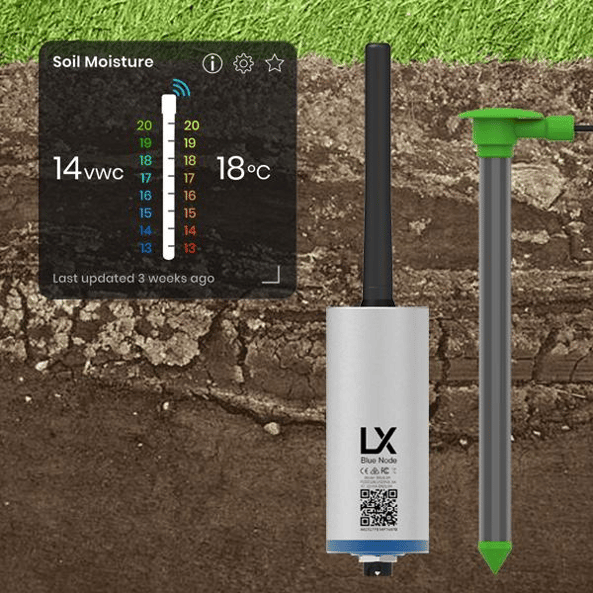There are various factors that need to be considered when choosing a location for your moisture probe. This article is written to help you choose the right spot.
To get the most accurate reporting out of your soil moisture probe there are several factors to consider. The location of a soil moisture probe and the number of probes you use across a paddock will impact the reporting as much as correct installation, so we’ve put together a list of some of the most common factors to consider when selecting a location for your soil moisture probe.
Factors Affecting Soil Moisture Probe Location:
- Ability to correctly install the probe
All of the connected soil moisture probes available in the LX kits with Blue Node should be installed using specialist equipment so that the full length of the probe is under the ground. When selecting a location, it is important to avoid any areas with known obstructions such as pipework.
- Ability to connect and install the Blue Node
Whilst the length of the probe should be underground to get accurate groundwater readings, the smart sensor cable and blue node need to be safely secured somewhere above ground level. So, at the edge of a paddock this might be to a fence post and you’ll need to consider the position of the SMP and Blue Node so they are easily accessible but not obstructing anything.

- Wireless Network Connectivity
If your Soil moisture probe and Blue Node are connecting via LoRaWAN or Private LoRa network, it’s good practise to ensure the probe is installed in a position to receive good network signal for reliable reporting. So, avoid low lying areas or dips and areas where there is dense vegetation between the device and the gateway.

- Soil Type
Soil type or profile can vary slightly across a paddock and from one location to another on your property and some soils are naturally more hydrophobic than others. Ideally you want a probe in each soil type to give you a holistic picture of the soil moisture levels across each paddock, so you can make data-informed decisions around irrigation processes.
- Land profile
Moisture will accumulate and last in soil at different rates depending on the lay of the land. Anything will experience run off and depending on permeability, groundwater content will be different at different points along a slope or in a dip. We’d recommend in paddocks that have this kind of profile that you place a probe at the top of the slope, the bottom and on the flat.
- Land use
Ground water content will be depleted at varying rates, depending on how you use the land across a property. Alongside different types of soil and land profile, you should consider soil moisture probes across different types of land use and paddocks to give you insights into how soil moisture is impacted by land use.

- Artificial Influences
Avoid areas that artificially impact the crop moisture or can cause soil compaction. Avoid wheel tracks and avoid getting right up against the edge of the paddock, ensure the probe is located in the cropping area, avoid contour banks, gullies, trees, and root systems.
Essentially deciding how many probes to deploy across a paddock or across your property will help determine the positioning. It comes down to what insights you want out of the devices. For example, if you want paired devices to see how soil moisture is impacted by different crops in adjoining paddocks, or if you have 2 or 3 different distinctive soil types across your property.
Like many connected sensors - the rich data you get from them really becomes useful when you look at it through the lens of the physical inputs you can see and your own knowledge and experience. Soil moisture probes are not automated devices, they won't tell you how to treat the soil in a particular paddock; what they’ll do is provide you with reports on the stuff you can’t see, so you can combine this with your knowledge to make the best decision.
Looking for more information on soil moisture probes?
If you can’t find the answer you’re looking for here, or have a support issue - you can lodge a ticket with our helpdesk at the link in the page header. Or for more general enquiries, drop us an email on enquiries@incyt.io
Check out our full range of soil moisture probe kits available here.
